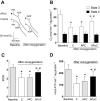Isoflurane protects cardiomyocytes and mitochondria by immediate and cytosol-independent action at reperfusion
- PMID: 20423337
- PMCID: PMC2874845
- DOI: 10.1111/j.1476-5381.2010.00698.x
Isoflurane protects cardiomyocytes and mitochondria by immediate and cytosol-independent action at reperfusion
Abstract
Background and purpose: The volatile anaesthetic isoflurane protects the heart from ischaemia and reperfusion (I/R) injury when applied at the onset of reperfusion [anaesthetic postconditioning (APoC)]. However, the mechanism of APoC-mediated protection is unknown. In this study, we examined the effect of APoC on mitochondrial bioenergetics, mitochondrial matrix pH (pH(m)) and cytosolic pH (pH(i)), and intracellular Ca(2+).
Experimental approach: Cardiac mitochondria from Wistar rats were isolated after in vivo I/R with or without APoC (1.4%-vol isoflurane, 1 minimum alveolar concentration), and mitochondrial permeability transition pore (mPTP) opening, mitochondrial membrane potential (DeltaPsi(m)), and oxygen consumption were assessed. In isolated cardiomyocytes and isolated mitochondria I/R injury was produced in vitro, with or without APoC (0.5 mM isoflurane). Intracellular Ca(2+), pH(m), pH(i) and DeltaPsi(m) were monitored with SNARF-1, TMRE and fluo-4, respectively. Myocyte survival was assessed when APoC was induced at pH 7.4 and 7.8. In isolated mitochondria oxygen consumption and ATP synthesis were measured.
Key results: In vivo APoC protected against mPTP opening, slowed mitochondrial respiration and depolarized mitochondria. APoC decreased the number of hypercontracted cardiomyocytes at pH 7.4, but not at pH 7.8. APoC attenuated intracellular Ca(2+) accumulation, maintained lower pH(m), and preserved DeltaPsi(m) during reoxygenation. Isoflurane did not affect the regulation of cytosolic pH. In mitochondria, APoC preserved ATP production rate and respiration.
Conclusions and implications: At reperfusion, APoC inhibited mitochondrial respiration, depolarized mitochondria and acidified pH(m). These events may lead to inhibition of mPTP opening and, consequently, to preserved DeltaPsi(m) and ATP synthesis. This reduces intracellular Ca(2+) overload and cell death.
Figures







Comment in
-
Mitochondria as pharmacological targets.Br J Pharmacol. 2010 May;160(2):217-9. doi: 10.1111/j.1476-5381.2010.00706.x. Br J Pharmacol. 2010. PMID: 20423336 Free PMC article.
References
-
- Abad MFC, Di Benedetto G, Magalhaes PJ, Filippin L, Pozzan T. Mitochondrial pH monitored by a new engineered green fluorescent protein mutant. J Biol Chem. 2004;279:11521–11529. - PubMed
-
- Aizawa K, Turner LA, Weihrauch D, Bosnjak ZJ, Kwok WM. Protein kinase C-epsilon primes the cardiac sarcolemmal adenosine triphosphate-sensitive potassium channel to modulation by isoflurane. Anesthesiology. 2004;101:381–389. - PubMed
-
- Brennan JP, Berry RG, Baghai M, Duchen MR, Shattock MJ. FCCP is cardioprotective at concentrations that cause mitochondrial oxidation without detectable depolarisation. Cardiovasc Res. 2006;72:322–330. - PubMed
-
- Buckler KJ, Vaughan-Jones RD. Application of a new pH-sensitive fluoroprobe (carboxy-SNARF-1) for intracellular pH measurement in small, isolated cells. Pflugers Arch. 1990;417:234–239. - PubMed
Publication types
MeSH terms
Substances
Grants and funding
LinkOut - more resources
Full Text Sources
Other Literature Sources
Miscellaneous

